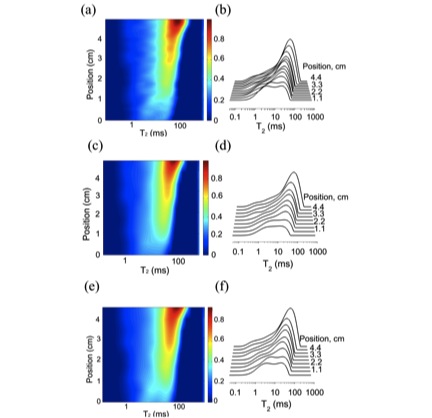A Comparison of Magnetic Resonance Methods for Spatially Resolved T2 Distribution Measurements in Porous Media
- University of New Brunswick, Physics, Fredericton, Canada
Naturally occurring porous media are usually characterized by a distribution of pore sizes. If the material is fluid saturated, the 1H magnetic resonance (MR) signal of the wetting fluid depends on the pore size, the surface relaxivity and the fluid itself. Measurement of the transverse relaxation time T2 is a well-established method to characterize material samples by means of MR.T2 distribution measurements are the most basic measurement employed to determine the fluid-matrix properties in MR core analysis [1].
Three methods for T2 distribution mapping, namely spin-echo SPI (SE-SPI) [2], DANTE-Z CPMG [3] and adiabatic inversion CPMG [4] are compared in terms of spatial resolution, minimum observable T2 and sensitivity [5]. SE-SPI is an imaging method, which measures spatially resolved T2s. A variant is introduced in this work that employs pre-equalized magnetic field gradient waveforms [6] and is therefore able to measure shorter T2s than previously reported. The DANTE-Z pulse train and adiabatic inversion pulse are compared in terms of T1 or T2 relaxation time effects during the RF pulse application, minimum pulse duration, requisite RF pulse power, and inversion profile quality. In addition to experimental comparisons, simulation results are presented .
For a Berea sandstone with a typical sandstone T2 distribution, employing 1.58 ms duration selective RF pulses, the T2 distribution measurement results are similar for SE-SPI and slice selective CPMG methods as shown in the figure. One may replace SE-SPI measurements by slice selective CPMG at the expense of losing high spatial resolution, but the T2 distribution measurements will feature higher sensitivity.
For slice selective CPMG methods, two inversion schemes, a DANTE-Z pulse train and an adiabatic inversion pulse were tested. The adiabatic inversion pulse may be applied in as short a time as 0.3 ms, which is very beneficial when measuring the T2 distribution for samples including short lifetime T1 and T2 components (< 5 ms).
Our conclusion is that adiabatic inversion (insensitive to B1 inhomogeneities) followed by a CPMG pulse train is the preferred way to measure local T2 distributions provided a regional measurement of coarse spatial resolution is sufficient.

- [1] J. Mitchell, T. C. Chandrasekera, D. J. Holland, L. F. Gladden, E. J. Fordham, (2013), Magnetic resonance imaging in laboratory petrophysical core analysis, Phys. Rep., 256, 165-225
- [2] O. V. Petrov, G. Ersland, B. J. Balcom, (2011), T2 distribution mapping profiles with phase-encode MRI, J. Magn. Reson., 209, 39-46
- [3] O. P. Petrov, B. J. Balcom, (2012), Local T2 distribution measurements with DANTE-Z slice selection, J. Magn. Reson., 215, 109-114
- [4] S. Vashaee. O. V. Petrov, B. J. Balcom, B. Newling, (2014), Region of interest selection of long core plug samples by magnetic resonance imaging: profiling and local T2 measurement, Meas. Scie. Technol., 25, 035004-035014
- [5] S. Vashaee, F. Marica, B. Newling, B.J. Balcom, (2015), A Comparison of magnetic resonance methods for spatially resolved T2 distribution measurements in porous media, Meas. Sci. Technol., 26, 055601-055617
- [6] F. G. Goora, B. G. Colpitts, B. J. Balcom, (2014), Arbitrary magnetic field gradient waveform correction using an impulse response based pre-equalization technique, J. Magn. Reson., 238, 70-76
